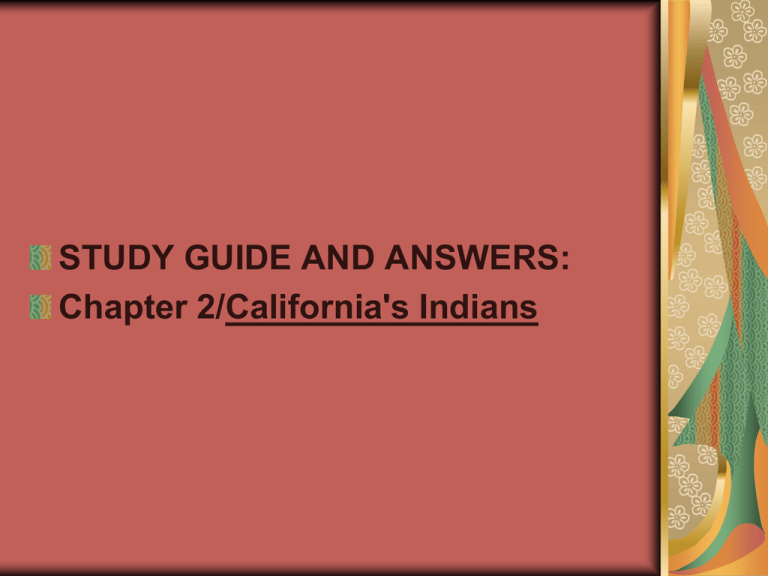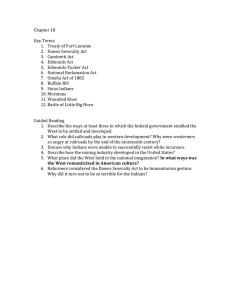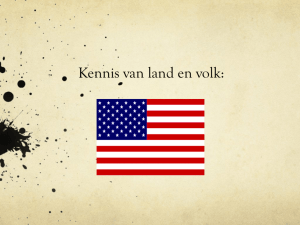Chapter 2 California's Indians Study Guide
advertisement

STUDY GUIDE AND ANSWERS: Chapter 2/California's Indians I. "The First Californians" A. A Time Long Ago 1. glaciers-slow-moving masses of ice 2. ancestors-early family members (from past) 3. How did early people depend on large animals? They hunted them for food and used their hides and bones to make clothing, shelter, and tools. B. A New Way of Life 1. surplus-extra 2. How did people adapt to the change in climate? They began to fish and to hunt smaller animals. They also gathered more nuts, berries, and plants for food. C. The California Indians 1. tribe-an American Indian group with its own leaders and lands 2. culture- people's own beliefs, and ways of speaking, acting, and dressing 3. How did the environment shape the ways of life of early California Indians? California Indians had to use the available plants, animals, and natural resources to survive. D. Learning From the Past 1. artifact- any object made by people in the past 2. legends-stories handed down over time 3. How were legends important to California Indians? Through legends, California Indians were able to pass down their history to new generations. *PLEASE DO HOMEWORK AND PRACTICE p. 13-14 II. "The Northern Coastal Region" A. The Land and People 1. Yurok, Karuk, Hupa, and WiyotThey are some of the groups of people that lived in the northern coast of California. 2. What natural resources did tribes in the northern Coastal Region use? They used trees and rivers. B. Yurok and Hupa 1. weirs-(fences) a structure stretched across a river to catch fish 2. ceremony-a celebration to honor a cultural or religious event. 3. shaman-a religious leader 4. Why were the Hupa able to make many beautiful objects? Food was usually plentiful, so they had time to create decorative objects. C. Pomo 1. How were Pomo houses along the coast different from those built inland? Houses on the coast were coneshaped and made of bark. Houses inland were built on a wooden frame and covered with brush, plant stems, or grasses. D. Wealth and Trade 1. trade-the exchange or buying and selling of goods 2. What did people in the northern Coastal Region use for trade? They used shells. *PLEASE DO HOMEWORK AND PRACTICE p.15-16 III. "The Southern Coastal Region" A. The Land and People 1. Chumash-one of the tribes native to the southern Coastal Region 2. Which tribes in the Coastal Region lived farthest south? The Luiseno and the Kumeyaay lived farthest south. B. Chumash 1. government-a system for deciding what is best for a group of people...provides a way for groups to make rules and choose leaders. 2. cooperate-to work together 3. How did the Chumash make use of the tar that bubbled up on their lands? They made their baskets and plank canoes waterproof. C. Gabrielino Luiseno, and Kumeyaay 1. How is the Gabrielino turtle legend similar to the Chumash Sun Legend? They both explain events in nature. *PLEASE DO HOMEWORK AND PRACTICE p.17 *Chart and Graph Skills-"Compare Tables" p.74-75 PLEASE DO HOMEWORK AND PRACTICE p.18-19 IV. "The Central Valley and Mountains" A. The Land and People 1. Achumawi, Maidu, Miwok, Nisenan, and yokutsThese are some of the tribes native to the Central Valley of California. 2. Why were many people able to live in the Central Valley Region? The region had a good climate and plenty of food. B. Maidu 1. granary-a building for storing extra acorns 2. division of labor-having different members of a group do different jobs 3. specialize -to focus on one job to do it well 4. How was work divided among the Maidu men and women? Men made arrow points and bows, fishing nets, and other tools. Women prepared food and made baskets. C. Miwok and Yokuts 1. How were oak trees important to the Yokuts? They used wood from oak trees to build homes and gathered acorns for food. V. "The Desert Region" A. Cahuilla 1. springs-water that flows through openings in the ground 2. Why did the Cahuilla sometimes leave their villages? They sometimes left their villages to gather food and natural resources. B. Cahuilla Lifeways 1. What item did the Cahuilla make that most other California Indians did not? They made clay pottery. C. Mojaves 1. arid-dry 2. silt-fine grains of soil and rock left along a river's banks 3. agriculture-farming 4. How was the Colorado River important to the Mojave? It was an important source of water. The silt deposited by the river provided rich soil for growing crops. 5. Who is Cheryl A. Seidner? 5. Who is Cheryl A. Seidner? 1950- An American Indian leader; elected tribal chairperson of the Wiyot tribe in 1996. *PLEASE COMPLETE HOMEWORK AND PRACTICE p.21 *PLEASE COMPLETE HOMEWORK AND PRACTICE: "Study Guide" p.22-24







